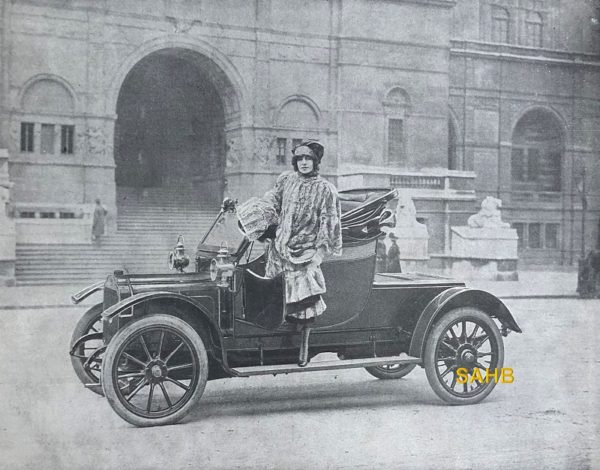
Motoring journals from the early days of motoring do not always tell us the name of the driver of a car – but with luck the make and model will be shown. The society magazines, however, often have the annoying habit of identifying the driver but not the car. This picture, from a 1910 issue of the French Femina magazine, mercifully came with both.
Firstly, the car. Mors dates back to 1851, when Monsieur Mirand founded a company to make artificial flowers with paper-wrapped wire stems, and his wire-wrapping machinery led him into electrical work, including the manufacture of telegraph and railway signalling equipment. The Mors family took over his firm in 1874 and later made steam-powered launches and petrol-engined railway inspection cars. An employee was Henri Brasier, later to be a famous car manufacturer in his own right. In 1895 Émil Mors built a Brasier-designed car; the company grew, and by 1898 were making 200 cars a year.
Sadly for Mors, Brasier left in 1901 to join Georges Richard, and in 1904 another of their designers, Charles Schmidt, left for Packard in the USA. Perhaps linked to these departures was the end in 1904 of any early Mors successes in competition – successes that started in 1899 with wins in the Paris-St Malo and Bordeaux-Biarritz races.
Poor management led to financial difficulties up to 1909, when Mors were saved from liquidation by a stockholder who brought his son-in-law’s brother into the business – that man was André Citroën. He doubled sales between 1909 and 1910 to 647 cars, with new, lighter and more modern models such as the 10 HP shaft-drive car in our Snapshot. From 1913 Mors offered sleeve-valve as well as poppet-valve engines – and their sleeve-valve cars stole a march in a very small way over Panhard’s use of SS (sans soupapes), being named SSS (sans soupapes silencieuse). In the Twenties the cars were sold in England by Malcolm Campbell, who raced one at Brooklands, but the company was dead by 1925 and Citroën took over the factory to produce his own cars.
And now to the lady driver. She is the singer and actress Polaire (“Pole-Star”), seen here descending from her car during her latest theatrical tour in England. Her real name was Émilie Marie Bouchaud (1874-1939). She worked first as a music-hall singer and dancer: one of her earliest hits was performing the French version of Ta-ra-ra Boom-de-ay. Having quickly made a name for herself – Toulouse-Lautrec portrayed her on a magazine cover in 1895 – Polaire briefly visited New York without much success. From 1902 she moved into serious theatre and the nascent film industry.
She was known for her wasp waist and lavish fur coats, and for her eccentric presence on and off the stage: on a more successful American tour in 1913 she was accompanied by a diamond-collared pet pig, Mimi, and wore a nose-ring. Her decline as an actress almost matched that of Mors: by the late 1920s she had to accept lesser roles. But she outlasted the car company: her last film appearance was in 1935.
Photo courtesy of The Richard Roberts Archive.







Leave a Comment